Unless you’re growing plants for their ornamental seed heads or want to save seed for the following year, ‘deadheading’ by removing the fading flower heads, extends the flowering season. It stops them from wasting energy producing unwanted seeds and prevents those that self seed freely, like ‘Lady’s Mantle’ or ‘Love in a mist’ from becoming a weed. Hybrid Tea Roses were traditionally cut back as the flowers faded, to a strong outward facing bud, often well below the flower and cluster flowered roses were treated likewise, once the blooms were over. However, current thinking for roses others, is that only a minimal amount of the stem should be removed keeping the maximum number of leaves on the plant to help with photosynthesis.
It’s impossible to deadhead plants which produce masses of smaller flowers but they can be fed with a general fertiliser as a boost after flowering to help them recover and hanging basket plants like ‘Lobelia’ can be trimmed with shears, fed with general fertiliser, then boosted with high potash fertiliser so they flower until the first frosts. Don’t feed your woody plants after mid-August or the new growth will be damaged by early frosts.

Powdery mildew often causes problems at this time of year, particularly during dry periods or on plants growing against hot, dry walls. Look out for a white powdery coating on young shoots, stems and leaves, different species attack a range of hosts from Clematis to marrows, courgettes and peas to ‘Honeysuckle’ and Phlox. Keeping the soil moist by watering and mulching, and maintain good air circulation in and around the plant controls the problem. Removing infected parts and clearing infected material at the end of the season helps, too, as does growing disease resistant plants or spraying with sulphur based sprays (Do this according to the manufacturer’s instructions and check that the plant is sulphur tolerant by spraying a small area first.). Organic sprays based on fish and vegetable oils are effective, too.
At this year’s Gardeners’ World Live, a visitor brought a picture of his roses infested with what seemed like hundreds of adult chafer beetles, the flower petals were disfigured and the damage they caused was incredible! A very sinister scene! Another gardener complained about foxes, which feed on the larvae, damaging his lawn. Between July and September is a good time to control Chafer grubs, applying the biological control nematode Heterorhabditis megidis to the lawn, according to the manufacturer’s instructions. Apply when the soil is moist, after a shower of rain; in drier spells you will need to water the lawn before applying.
Cut back delphiniums, foxgloves and herbaceous geraniums after they have finished flowering. Feed with general fertiliser and water well and they will produce another flush of flowers. While we are on the subject of flowering, flower buds of rhododendrons, magnolias and camellias form between July and September, so keep them well watered for the next few months using rainwater if they are in pots and look forward to a wonderful display next year. Happy gardening!


